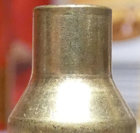Hi folks,
Getting ready to start loading for an AR I just built. 20" heavy fluted barrel from BCA with a 1:9 twist. BCA's picture on their website that was with the barrel showed a .161 test group with 69gr Noslers.
I know being a semi-auto AR that I will need to full length resize every case, and also load COAL to mag length as a maximum. What I'm curious about, is the use of a body die, say from Redding, to full length resize the case minus the neck, and then follow that up with a Lee collet die to size the neck.
I plan to do some testing to see if I need to crimp the rounds or not. I will load 3-4 rounds of factory ammo in the mag on top of one of my reloads that have not been crimped, and then after firing the factory ammo, checking my reload to check for any changes to OAL. Then chamber it and check again. If I need to crimp I will, I have the Lee factory Crimp die already.
I bought 100 69g SMKs and 100 73g Hornady ELD-M for testing. Going to use an old can of Varget I have just to see what I can get the rifle to do, but plan to switch to 4064, 4895, or RL15 later on because of the scarcity of Varget.
LC
Getting ready to start loading for an AR I just built. 20" heavy fluted barrel from BCA with a 1:9 twist. BCA's picture on their website that was with the barrel showed a .161 test group with 69gr Noslers.
I know being a semi-auto AR that I will need to full length resize every case, and also load COAL to mag length as a maximum. What I'm curious about, is the use of a body die, say from Redding, to full length resize the case minus the neck, and then follow that up with a Lee collet die to size the neck.
I plan to do some testing to see if I need to crimp the rounds or not. I will load 3-4 rounds of factory ammo in the mag on top of one of my reloads that have not been crimped, and then after firing the factory ammo, checking my reload to check for any changes to OAL. Then chamber it and check again. If I need to crimp I will, I have the Lee factory Crimp die already.
I bought 100 69g SMKs and 100 73g Hornady ELD-M for testing. Going to use an old can of Varget I have just to see what I can get the rifle to do, but plan to switch to 4064, 4895, or RL15 later on because of the scarcity of Varget.
LC


















